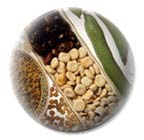- Home
- Introductions

|
Vegetable Seed Production
|
 |
Common Name:
Tomato Scientific Name: Solanum lycopersicum Family Name: Solanaceae |
Tomato introduction & history
The tomato is a warm season (frost intolerant), perennial that is grown
as an annual in temperate regions. Solanum lycopersicum is self
pollinated.
The tomato is of New World origin and was unknown to Europeans until samples
were collected by early explorers in Mexico and returned to Europe. Wild
species are found in the Andean region, Peru, and adjacent areas. The
wild form is believed to have been taken to Mexico, where fairly advanced
domestication occurred by native people in what is today Mexico. The wild
cherry tomato, L. esculentum var. cerasiforme, is spontaneous through
tropical and subtropical America and is probably the progenitor of the
cultivated tomato.
There is early mention of the tomato being used as a food crop in Italy
in 1554. Tomato was at first considered poisonous in the English speaking
countries probably because of its relationship to nightshade (both are
in the same family). Tomato leaves and immature fruit do contain the toxic
alkaloid tomatine. The tomato was grown in the early American colonies
as a curiosity (love apple) and not widely accepted as a food crop in
this country until after 1800.
Tomato Seed Production and Identification page
 |
Common Name:
Pepper Scientific Name: Capsicum spp. Family Name: Solanaceae |
Peppers are a warm season (frost sensitive) perennial that are grown commercially as annuals. There are many similarities to tomato. Like the tomato, the fruit of the pepper is a berry, but its structure is considerably different. When the fruit is very small it is very much like the tomato but as it grows, the outer wall or pericarp, grows much more rapidly than the placenta. This results in the formation of a large air-filled cavity in the fruit. In cross section near the apical end it is difficult to tell how many carpels there are in the fruit.
The genus is strictly of New World origin. Wild plants are found from
southern United States to southern South America.
Peppers were domesticated and used as a food plant for many centuries.
Their use was principally as a condiment. Peppers were identified from
excavations to have existed about 7000 B.C.
Columbus was probably the first to take specimens to Europe. There, they
were eventually adopted as food crops and quickly moved into usage through
most of the world. The non-pungent types were more popular in Europe.
Historically pepper has been considered to have medicinal values. Years
ago peppers were believed to be effective for curing dropsy, colic, toothache
and cholera. Today pepper extracts are used as counter-irritants for rheumatism
and as a constituent of some throat gargles and lozenges.
Pepper Seed Identification page
 |
Common Name:
Eggplant Scientific Name: Solanum melongena Family Name: Solanaceae |
The eggplant is a warm season (frost intolerant) perennial that is grown
as an annual and requires a longer growing season than its relatives tomato
or pepper.
It is an old world crop believed to be native to India and has long been
a cultivated crop in southern and South East Asia.
Some authorities claim that it was used as a food crop as early as the
5th century.
Eggplants were probably introduced into southern Europe during the Moorish
invasion of Spain.
Eggplants were introduced to the Americas by early Spanish explorers,
but until the 20th century, the plant was used in the U.S. more for ornamental
purposes than for human consumption. Much like tomato, people believed
the eggplant to be poisonous for many years before it became a popular
because it is related to nightshade. My grandmother would soak eggplant
in salt water before cooking to remove the "poison".
Eggplant Seed Identification page
 |
Common Name:
Potato Scientific Name: Solanum tuberosum Family Name: Solanaceae |
Solanum tuberosum is a tetraploid (4N = 48) and does not grow true to type from seed so it is propagated vegetatively by the tubers. Each tuber contains several eyes or buds. Potato tubers exhibit apical dominance like other plant organs, so cutting tubers into pieces stimulates the eyes to sprout.
The potato is often called white potato or Irish potato to differentiate
if from the sweet potato, which is a member of a different plant family
and not closely related to Irish potato.
Plants are small bushes with pubescent stems that grow up to 1 meter long.
Flowers range in color from white to bluish, 1 to 1 1/4 inches across.
Flowers are mostly perfect (bisexual) with 5-lobed calyx. A superior 2-
celled ovary normally contains many ovules with one style and the stigma
is simple or lobed. Fruits are infrequently produced and are 2- or 3-celled
globular yellowish or green berries 3/4 inch or less in diameter.
Tubers form on the ends of underground stems called stolons when induced
by the proper daylength. Commercially potatoes are grown as annuals in
the United States.
The potato originated in the Andean region of South America, probably
in Chile.
The potato has been cultivated by natives of South America for perhaps
2,000 years before the arrival of the Europeans. Hundreds of species still
grow wild in South America.
Potato Seed Identification page